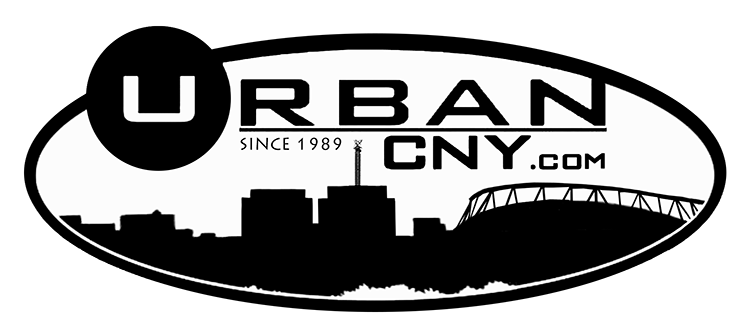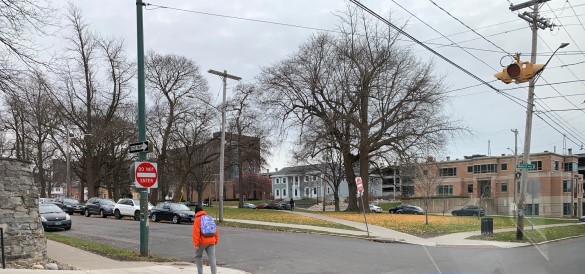This is a story about control
Our control
Control of where we play
Control of what we do
And this time I’m gonna say it my way
I hope you enjoy this as much as I do
Are you ready?
I am
‘Cause it’s all about control*
And we’re about to lose it)
I grew up on Harrison St. across from Walnut Park, our house was on the campus map. When they told me to go home or “back to the south side” I proudly said, “I am home”. We lived in that house from 1960 – 1978 and during that time what I witnessed was the considerable shrinkage of public use property. While on maps and books they’re still part of the city of Syracuse, however in reality, entries to formerly public streets have become gated bastions. Previous agreements gave residents access to the streets after 5:00 pm. Access covenants are rarely enforced on behalf of the people.
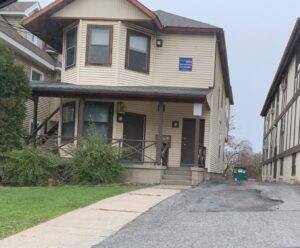
Growing up on campus was like constantly viewing a panoramic diorama. Colorful 3D images in memory. Dutch Elm trees lined Harrison Street, taller than most houses forming a canopy during the peak of summer’s heat. Fraternities and Sororities lined both Walnut Ave and Walnut Place with the four-block park in the middle. Everything on campus had a season. And like an interconnected organism, the neighborhood would move in sync with the University.
They weren’t giving mortgages to black people in that neighborhood. My mom was very creative, we had a Jewish lawyer and Joe Atkins was the Black realtor, the seller held the mortgage. Across the street was Walnut Park.
Marshall Street was my friend. I must have been the kid mascot for a while, because I had little jobs along what was then called “M Street”. The merchants lived in the neighborhood; it was the laid-back time of the 1960’s. We lived within a few blocks of both Marshall Street’s commercial district and the commercial district of East Genesee Street. At the time, this was a neighborhood inhabited mostly by people of color. If you wanted any Black magazine, newspaper, Dream Book or Black hair product you went to Harvey’s Drug Store. Liberty Market was a grocery store that catered to the needs of that neighborhood. And you didn’t do anything wrong because your parents knew the owners of Essie’s Store or Liberty Market! And Phoebe’s was where you went to play your numbers.
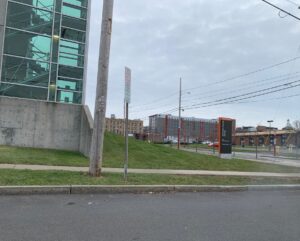
Vietnam War Protests would pass by the house, I recall a silent candle lit procession to the War Memorial, little did I know I had front row seats to the student protests against the war in Vietnam.
Urban Renewal ended within a block of the house. As neighborhood dwellings were vacated for demolition we’d have a new fort, instead of building them from old plywood, we had full size houses to play in.
Thornden Park was like a second home, in the summer especially. City of Syracuse Parks & Recreation programmed in the park. We had arts & crafts, there were people that worked with us kids, they taught us, play.
Before the neighborhood was torn down to the immediate north and west, the area was full of children. Two churches played a pivotal role in our daily lives. Grace Episcopal Church held programs for us during the morning with Ms. Ester Green, in the afternoon we would all go to University Methodist Church that programed for the afternoon. We had full days, full of activities. When we weren’t in funded church programs, we were in supervised play at Thornden Park. In the winter, we improvised, why get a sled when you can fly down a snow-covered Thornden Park hill in a repurposed Kenmore appliance box.
Our immediate neighbors were mostly students residing in Syracuse University owned buildings. At the time there were student living arrangements that were cooperative. The closest to our home was Co-op II, a converted residence, in between was the home of Laubach Literacy, which has morphed into a global operation located on the city’s west side.
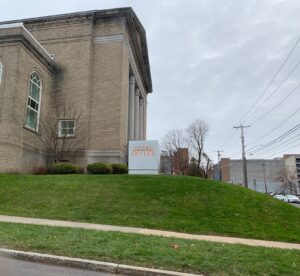
The Black families that did live in the area were run out by university expansion. Areas that were once inhabited by Black families are now high-end apartments. Portions of Thornden Park are unusable during the week due to its proximity to the university, as the park serves as an extended daily use parking facility for Syracuse University.
My parents and neighbors painted and fixed, not a sight of pealing paint or blight. Mr. and Mrs. Kemp who were our neighbors, their home was immaculate. But one house down was Syracuse University owned housing. Co-op II was home to students, while it was once a grand residence typical of that area, the university made it a student living facility. What I witnessed over 18 years was the total abdication of responsibility by the university.
During that period, Syracuse University engaged in letting their properties run down, impacting everyone in the neighborhood including my parents. I never saw a home with the paint pealed down to its bare wood. But that began to happen to many of the university owned housing units in the immediate area.
In 1978, my parents were made an offer they couldn’t refuse, so after 16 years we moved to Barrington Road. In the meantime, it was announced that Syracuse University would be tearing down “crumbly old” Archbold Stadium and building what was to become the Carrier Dome.
The person that bought my parents house was a Syracuse University employee working in an area where he had direct knowledge of the university’s plans. After the closing, according to reports at the time, he was removed as he’d speculated on property using inside information. He then sold the properties to a relative.
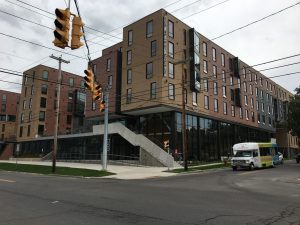
Syracuse has come a long way, now let’s recap: We’ve allowed Public Housing to disappear as we know it; Pioneer Homes, Central Village, McKinney Manor; all being replaced by a newly constructed neighborhood from the ground up.
Residents in the existing old units will be displaced. However, HUD rules required replacing the number of units once the new community is built.
The Syracuse University Nancy Cantor inspired Connective Corridor brought us extremely high rents; it effectively priced the average Black person in Syracuse out of neighborhoods they’ve inhabited for decades. We’ve seen the proliferation of Communities-in-a-box, offering parking, coffee shops and pet washing stations as amenities.
SU/City Services Agreement
See copy of SU City Services Agreement
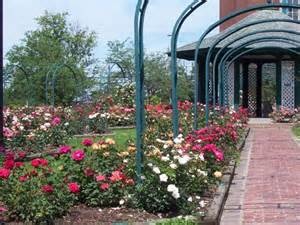
Even with these seemingly generous agreements, the condition of neighborhoods inhabited by poor residents aren’t improved by the university’s actions. They’ve pealed off funds to assist one specific neighborhood that’s adjacent to the eastern edge of campus. While those living in other areas, inhabited by mostly poor black residents go wanting. The difference between the neighborhoods? Those living on the university’s eastern edge vote. They have incomes much higher than the average African American Syracusan. Those living on the western edge are impacted by Syracuse University and get nothing but a new ground level highway.
Cities were created to collectively provide services for the public good. That used to include libraries, streets, sewers, public safety and parks. Cities are supposed to be advocates for a better quality of life for all, not just a select few that can afford to influence. Once a city loses control of these activities, is it really a city or a community that sold out piecemeal to the highest bidder?
Yes, this is a story about control. Control of where we play, control of where we live. And now, we’ve lost it.
cover image: Walnut Park at Harrison and Walnut Ave.
*altered spoken word intro inspired by Janet Jackson see music link Control







